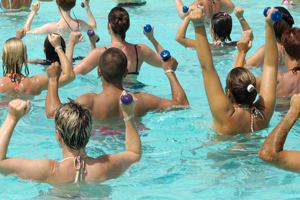 Although water aerobics have long been recommended for the elderly, pregnant women and those recovering from injury, it is a form of exercise that is good for people of all ages and fitness levels. It is a gentler way to exercise, but don’t let that fool you; water aerobics is a great way to improve cardiovascular fitness, increase flexibility, build muscle and burn fat.
Although water aerobics have long been recommended for the elderly, pregnant women and those recovering from injury, it is a form of exercise that is good for people of all ages and fitness levels. It is a gentler way to exercise, but don’t let that fool you; water aerobics is a great way to improve cardiovascular fitness, increase flexibility, build muscle and burn fat.
According to the Mayo Clinic, performing an hour of water aerobics burns more calories than the equivalent time doing a number of other sports, including downhill skiing, volleyball and weight training. These types of sports can put a great deal of wear and tear on the body’s muscles and joints. However, by exercising in water, the weight of your body is reduced by up to 90 percent, which makes it a great way to keep in shape, especially if you are overweight, suffering from arthritis or have an injury that would otherwise keep you from exercising.
Water aerobics is considered to be an exercise of moderate intensity, with a 30-minute workout burning an estimated 145 to 380 calories, depending on your weight. It is an ideal cardiovascular activity that works the heart without putting as much stress on it as land-based exercises; the heart rate can be up to 17 beats per minute less when performing water aerobics.
Better than your typical strength training workout that uses weights, particularly for those with musculoskeletal problems, water aerobics provides a significant amount of resistance, which can build and tone your muscles without putting excessive stress on your joints. Exercising in water provides 12 times the resistance of working out on land. If you feel the level of resistance is not sufficient, you can add a few items of specialized water aerobics equipment to your routine, such as water weights, webbed gloves or ankle cuffs. One word of caution, however: According to the Mayo Clinic, the resistance of water aerobics is not sufficient to reduce the risk of osteoporosis, so you should add some traditional weight training to your regular exercise routine to keep your bones strong, which can include such low-impact things such as walking, gardening and climbing stairs.
Performing water aerobics can also improve your level of flexibility, particularly if performed in warm water. Because the water supports so much of your weight, it is easier to stretch the muscles and move your joints through a greater range of motion.
Many facilities with a pool offer water aerobics classes of varying intensity. Look for one that starts with a warm-up, progressing to greater intensity that focuses on building cardiovascular and muscle strength. It should then progress to some cooling down exercises where you can stretch your muscles and work on flexibility. It’s a great way to keep fit while reducing your risk of injury.

